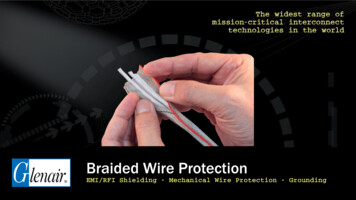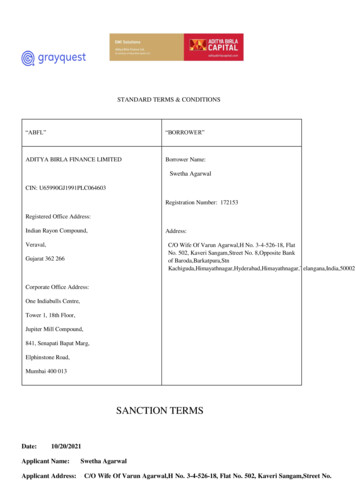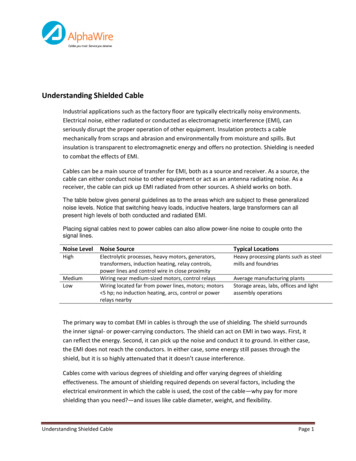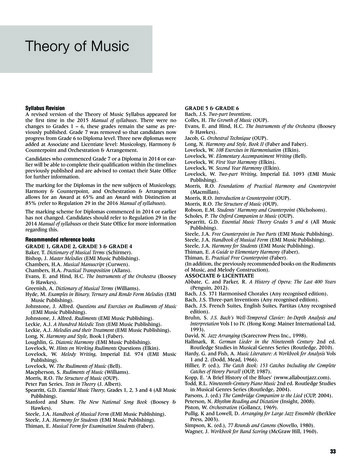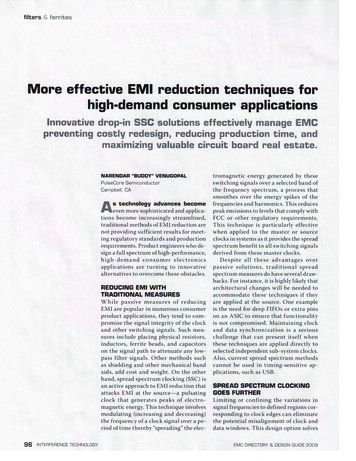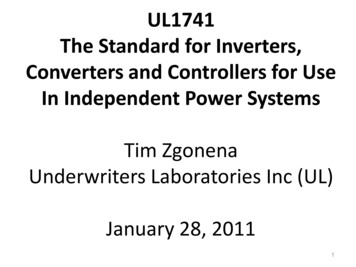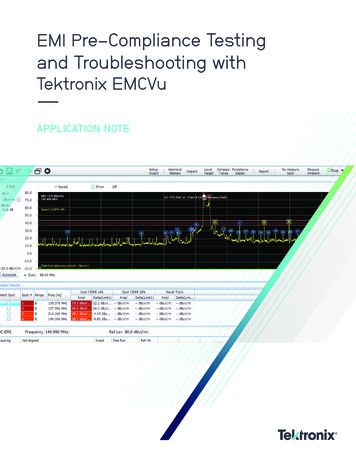
Transcription
EMI Pre-Compliance Testingand Troubleshooting withTektronix EMCVu––APPLICATION NOTE
APPLICATION NOTEEMI Pre-Compliance Testing and Troubleshooting with Tektronix EMCVuElectromagnetic compatibility (EMC) and the relatedelectromagnetic interference (EMI) seems to be one of thosenecessary evils that must be overcome prior to marketingcommercial or consumer electronic products, as well asmilitary and aerospace equipment. Unfortunately, fewuniversities and colleges teach this important information,with the result that products are rarely designed to meet EMC/EMI requirements. EMC or EMI compliance is often left to theend of a project with all the associated schedule delays andunplanned cost.The purpose of this application note is to help productdesigners or EMC engineers learn enough basics of EMCand EMI so that the usual design failures are addressed earlywhen costs and design is minimized. Achieving EMC/EMIis easy once these basics are understood. This applicationnote will also focus on measuring and mitigating radiated andconducted emissions using Tektronix EMCVu EMI software.Briefly, radiated emissions is a measure of the radiated E-fields,Basic DefinitionsLet's start with some basic definitions, and there's a subtledifference. EMC implies that the equipment being developedis compatible within the expected operating environment. Forexample, a ruggedized satellite communications system whenmounted in a military vehicle must work as expected, even inthe vicinity of other high-powered transmitters or radars. Thisimplies both emissions and immunity in close environments.This usually applies to military and aerospace products andsystems, as well as automotive environments.EMI (also sometimes referred to as radio frequencyinterference, or RFI) is more concerned with a productinterfering with existing radio, television, or othercommunications systems, such as mobile telephone. Italso includes immunity to external energy sources, such aselectrostatic discharge and power line transients. This usuallyapplies to commercial, consumer, industrial, medical, andscientific products.while conducted emissions is a measure of the conducted EMIcurrents emanating from the product, equipment, or systemunder test. There are worldwide limits on how high theseemissions can be, depending on the environment in which theequipment is designed to work.Today, with all the myriad electronic products, includingwireless and mobile devices, compatibility between devices isbecoming even more important. Products must not interferewith one another (radiated or conducted emissions) and theymust be designed to be immune to external energy sources.Most countries now impose some sort of EMC standards towhich products must be tested.Why Do Products Radiate?So, why do electronic products radiate? It's all aboutcontrolling the energy from internal sources from coupling tosystem cables (I/O or power) or slots/seams if using shieldedenclosures.For example, the most common issue for most products isradiated emissions. We generally have several energy sourceson our PC boards, and somehow, these energy sources coupleharmonic currents to an "antenna-like structure", such as anI/O cable. See Figure 1.Energy Coupling Path Antenna EMIFIGURE 1. A simple model for radiated emissions. The energy sources can include high frequency clocks, data/address buses, or other high frequency, fast-edged,signals. The “antenna” is usually I/O or power cables. Take away any of the three elements and you have no EMI.2 WWW.TEK.COM
EMI Pre-Compliance Testing and Troubleshooting with Tektronix EMCVuAPPLICATION NOTEInternal energy sources might include high frequencymode and common mode filtering right at the I/O and powerclocks or any high speed, fast-edged digital signal. Theseconnectors of the PC board. High-speed clock signals or noisymay be transferred via conduction, radiation, inductive, orinternal cables must be routed well away from I/O and powercapacitive coupling mechanisms. For example, a commonconnectors.situation is harmonics of a fast-edged clock (say an Ethernetclock) coupling to an I/O cable, which acts as an antennaand radiates. If these harmonic emissions exceed certaincompliance test limits, the product fails and must beredesigned to reduce or eliminate the emission. In a likePoor PC board design – Many emissions problems can bemitigated by proper PC board design. Common design issuesinclude: Poor layer stack-up – All layers with high-speed signals orclocks are transmission lines must have an adjacent groundreturn plane. In addition, all power traces (or planes) musthave an adjacent return plane, since the power distributionnetwork (PDN) is considered a transmission line, as well. Gaps in ground return planes - All return planes must besolid, without large gaps or slots. When a high-speed signalor clock trace crosses a gap in the return plane, it createslarge amounts of common mode currents, which canpropagate throughout your PC board and internal cables.If the I/O or power cables are not properly filtered or if theI/O or power cable shields are not properly terminated to ashielded enclosure, then these cables tend to radiate andmay cause emissions failures. Poor layout of circuit functions – Digital, analog, motorcontrol, and wireless circuitry should be well isolated fromeach other within the PC board real estate. For example,you wouldn’t want return currents from the motor controlcircuitry passing through sensitive analog circuit returns.Likewise, on-board DC-DC converter currents should berestricted to just a small area and away from other circuitry.manner, energy sources may couple to power cables andcreate conducted emissions into the AC (or DC) power line.Common Product Design IssuesWe'll start by describing some common product design issuesto be aware of during product development. If these designareas are addressed well in advance during the productdevelopment cycle, costs and related EMC troubleshootingand compliance testing will be minimized.Cable shield termination – By far the most common issuecausing radiated emissions is I/O or power cables merelypenetrating through shielded enclosures. This occurs whencable connectors are soldered to PC boards and the boardmounted inside the enclosure. Once a cable is plugged in tothe connector, it effectively penetrates the shield allowing EMInoise currents to flow out along the outside of the shield andthen radiate like an antenna. To mitigate this, the cable shieldneeds to be bonded (ideally a 360-degree connection) to thesome PC board mount connectors have built in EMI gasketsPre-Compliance versus ComplianceTestingthat press up to the inside of the enclosure.While investing in your own full in-house compliance EMC testshielded enclosure. Bulkhead connectors will resolve this orLeaky shielded enclosure seams or apertures – The nextmost common issue is simply areas where enclosure seamsare not well bonded or aperture areas in the sheet metal wherekeyboards or displays are mounted. Mitigating this usuallyrequires a more robust mechanical design or the addition ofEMI gasketing to bond seams or gaps.laboratory may seem difficult to justify, most companies shouldbe able to implement an affordable pre-compliance testingcapability. Outside compliance test labs can cost upwards of 2,000 per day. The advantage of being able to perform someof the key tests in-house is that you can quickly determinewhether your product is close to passing.Lack of filtering for I/O or power cables – Many commercialor consumer products can’t justify shielded enclosures andso the first line of defense must include adequate differentialWWW.TEK.COM 3
APPLICATION NOTEEMI Pre-Compliance Testing and Troubleshooting with Tektronix EMCVuCatch problems earlySave timeHelp designDesign 90%CompletedPre-complianceTest withspectrum analyzerIn House Time ConsumingReport failures onlyExpenxieveCompliance TestTest HouseFailPassFailEMI TroubleshootingFIGURE 2. Suggested product development and test workflow.A suggested product design workflow is pictured in Figure 2.probes and a spectrum analyzer. The goal is to identify sourcesOnce the product emissions are characterized and mitigated,of harmonic energy and determine fixes that reduce thethen it’s off the third-party test house for compliance testing.harmonic amplitudes. Here, we’re mainly looking for relativeMany companies work for weeks or months to beat down achanges.radiated emissions problem by repeatedly cycling betweenPre-compliance testing, on the other hand, attempts totheir R&D lab and third-party compliance test lab. This is veryduplicate the way the compliance tests are run to the bestfrustrating for both the designers and their management. Byability possible and to compare with actual test limits. Thisperforming some very quick and simple tests, you can identifyrequires a calibrated EMI antenna and knowledge of the gainsfailures, narrow down the root cause, and try various fixesor losses in the measurement system.well before taking the product in for full compliance testing.Tektronix offers some affordable spectrum analyzers andsoftware, such as EMCVu, to make this job fast and easy.For best results, the radiated emissions test is usuallyperformed inside a semi-anechoic chamber in order toeliminate outside received signals (ambients), such asEMI Troubleshooting versusPre-Compliance Testingbroadcast radio, television, two-way radio, or cellularThere’s a difference between general troubleshooting orshielded chamber and special techniques are used to separatedebugging EMI issues and pre-compliance testing. Generalambient signals from those emanating from the product undertroubleshooting is usually performed with a set of specializedtest.4 WWW.TEK.COMtelephone. However, this can be relatively expensive, so mostin-house pre-compliance tests are normally set up outside a
APPLICATION NOTEEMI Pre-Compliance Testing and Troubleshooting with Tektronix EMCVuReal-Time Spectrum Analysisselected resolution (or “receiver”) bandwidth. RF signalsintroduced to the input port are mixed with the local oscillatorThe latest tool for serious EMI troubleshooting or debuggingand the specified frequency span (stop frequency minushas become the real-time (RT) spectrum analyzer. Becausestart frequency) is displayed as RF power or voltage versusmanufacturing costs have been decreasing, some RT analyzersfrequency. The only time data is captured is during theare becoming more affordable than ever. In this section, we’llsweep time. After the frequency sweep, the captured data isshow you the advantages in using RT analysis for observingprocessed and displayed. There is usually significant delay (orand troubleshooting unusual EMI.“dead” time) between sweeps, so it’s quite possible for theanalyzer to miss capturing intermittent or fast-moving signals.First, let’s review the differences between the conventionalDisplayResolutionEnvelopeVideoAlso, mostdigitally-tunedswept analyzers can only displayBandwidth Detector BandwidthaFilterfixed numberofFiltertuning steps. For example, for the typical(SLVA)Low-Passswept and real-time spectrum analyzers. Youmight also referRF DownconverterAttenuatorto the system block diagrams in Figure 3. We’ll also brieflymention EMI receivers.Yradiated emissions test, theresolution bandwidth is set toInput120 kHz. If the display uses 1000 display points and you setYIGSwept-tuned analyzer – The swept analyzeruses a tunablePre-Selectorlocal oscillator (LO) in a standard superhetrodyne circuit. Itcan sweep over a specified frequencyrange using a userSweepthe span from 30 to 1000 MHz (970 MHz span), the step sizeSwept TunedLocalwillOscillatorXbe about 1 MHz apart, with a chance of missing signals inbetween.Generatora) Swept Tuned Spectrum Analyzer (SA)Resolution EnvelopeBandwidth DetectorFilter(SLVA)Low-PassRF DownconverterAttenuatorYLow-PassRF DownconverterAttenuatorIF FilterYIGPre-SelectorInputSweepGeneratorADCSwept TunedLocalOscillatorBand-PassLocalOscillatorPost Capture illator OscillatorAcquisition BandwidthPost Capture ProcessingLow-PassIF FilterReal-Time DigitalADCReal-TimeCorrectionsIQ out(option 05)LocalOscillatorri165 MHzDownconvertAcquisition Bandwidth& FilterCaptureReal Time EngineAmp./PhaseInputFreeRunLive SignalProcessingPost CaptureDPXDisplaysDDC/MemoryDecimation DisplaytriggerAnalysisX-YExtReal-Time Bandwidth400MS/sX-YModern FFT-Based AnalyzersRF DownconverterBand-PassDisplaysCapturePX-Yb) Vector Signal Analyzer (VSA)AttenuatorXPost CaptureDisplayDownconvertDigital& FilterFilterIF FilterADCBand-PassBand-PassMemoryReal-Time DigitalRF DownconverterIF FilterInputX-YModern FFT-Based AnalyzersAttenuator AttenuatorPAnalyzer Block DiagramRF DownconverterLow-Pass Low-PassDisplayMicroProcessorAcquisition Bandwidtha) Swept TunedSpectrumAnalyzer(SA)SweptTunedSpectrumb) VectorSignal DisplayVideoBandwidthFilterDisplay ProcessingRunFIGURE 3. Block diagram showing the differences between swept and real-time spectrum analyzers.165 MHzAcquisition BandwidthMicroProcessorc) Real-Time Spectrum(RSA5100(RTSA)Series)r Block FreeLive SignalProcessingDPXReal Time EngineReal-TimeIQ out(option 05)DisplaytriggerAnalysisX-YWWW.TEK.COM 5
EMI Pre-Compliance Testing and Troubleshooting with Tektronix EMCVuAPPLICATION NOTEEMI receiver – An EMI receiver uses a tuned local oscillatorOne advantage of a RT analyzer is the ability to capture RFfront end with tracking pre-selection filters, similar to an AM/pulses as short as 20 us, digital modulations, and other pulsingFM broadcast radio. There are many advantages, but theor fast changing signals. In addition, they can capture andprimary ones include a continuously-tuned receiver, so theprocess data much faster than swept analyzers – there’s nochances of missing signals due to stepped-tuning across aneed to wait seconds or minutes to capture a spectrum in Maxfrequency span is eliminated. Also, the preselection filtersHold mode. This allows very fast troubleshooting since you canreduce the chance of strong signals outside the frequencysee the result of fixes immediately. Finally, the RT analyzersspan from interfering with an accurate amplitude measurement,have an addition feature called a spectrogram (or “waterfall”)something you need to be aware of with swept-tuned and real-display, where signal amplitudes are shown versus time. Thistime analyzers with “wide open” RF inputs.is a great feature allowing you to determine the timing ofReal-time analyzer – A real-time (RT) analyzer uses astationary LO, looks at narrow windows of bandwidth (realtime bandwidth), and digitizes the incoming spectrum. Thisintermittent EMI. Tektronix RT-series analyzers also offer upto 8000 display points across a set span, so the chances ofmissing signals in between frequency steps is greatly reduced.digitized spectrum is stored in a time record buffer and heldFor the example shown, we’ll be using the Tektronix RSA306Bfor processing by the FFT algorithm. Ideally, once digitized,real-time USB-controlled spectrum analyzer (Reference 1) withFPGAs process FFTs at a rate equal, or faster, then theTekbox Digital Solutions near field probes (Reference 2).collection rate. However, this collection rate depends on thespan and resolution bandwidth. The major difference betweenthe swept-tuned analyzer and real-time analyzer is the sheernumber-crunching ability of the real-time calculation, as wellas a fast graphics processor, which allows for a data-densedisplay of various frequency-versus-time presentations anddigital demodulation.Figure 4 shows a typical advantage of the RT display over thatof the swept display. Here, we see some broadband motornoise completely masking several narrow band harmonics. Theswept analyzer has trouble capturing the motor noise, but wecan see occasional captures indicating there was “something”there. Switching to Max Hold mode and waiting a few minuteswill help fill in the swept display, but then you’d miss seeing thenarrow band emissions.6 WWW.TEK.COM
EMI Pre-Compliance Testing and Troubleshooting with Tektronix EMCVuAPPLICATION NOTEFIGURE 4. An example where the broadband emissions from a motor controller completely masks a series of narrow band harmonics. You can see on the right that thestandard swept analyzer has trouble capturing this broadband noise.Most RT analyzers will also have optional EMI software thatwill help collect data or even perform pre-compliance testingfor radiated and conducted emissions. For example, TektronixHow Can Real-Time Analyzers HelpTroubleshoot EMI?offers their SignalVu-PC software with the RSA306B, butSo, let’s turn our attention back to probing the PC board andalso recently announced their EMI troubleshooting and pre-cables. How often have you probed, troubleshot, and fixedcompliance software for the RSA-series, called “EMCVu”.a product only to have it fail at the compliance test facility?EMCVu includes some impressive EMI troubleshooting andMany of today’s products, especially mobile products, includepre-compliance test features and can switch from one modeon board DC-DC converters that produce a very broadbandto the other quickly. It comes with pre-defined transducerEMI spectrum out past 1 GHz that can impact the operationfactors (antenna and cable loss tables), CISPR and FCC limitof cellular or GPS wireless receivers. In addition, digitallines, and easy report generation. In pre-compliance mode,processors can change emission characteristics with timeit can scan the entire frequency range in a few seconds,or operating mode. Add wireless features and you have anumbering all the harmonics above the limit and within amyriad of potential energy sources that can change emissioncertain margin to the limit. These captured harmonic signalscharacteristics with time.can then be examined more closely and then switched overto troubleshooting mode to try various fixes. We’ll be usingEMCVu for basic troubleshooting or debugging emissionissues for this application note.We’ll demonstrate an example where swept analyzers mightvery well miss a bursting increase in emissions or fail tocapture broadband EMI that is greater in amplitude than theusual narrow band harmonics we’re all used to.WWW.TEK.COM 7
EMI Pre-Compliance Testing and Troubleshooting with Tektronix EMCVuEXAMPLE – PULSATING BROADBAND HARMONIC EMIMost of the time, you’ll find narrow band harmonics arerelatively stable in amplitude. However, there are times whenthe amplitude can change, due to gated digital signals ordifferent operating modes. If the harmonic peaks upward at thewrong time, it can lead to compliance failures.Swept analyzers can easily miss these infrequent amplitudeAPPLICATION NOTEhelp, but it could take several minutes to capture the peak ofthe emission. Even so, peaks can be missed, due to dead timein between scans.RT analyzers, on the other hand are adept at capturing fastchanging signals. Here’s an example where we’re measuringthe narrow band low frequency emissions from an on-boardDC-DC converter on a small mobile device (Figure 5).peaks. Placing the swept analyzer in “Max Hold” mode canFIGURE 5. Using a near field (H-field) probe on an on-board DC-DC converter in a small mobile device. I’m using the Tektronix RSA306B USB-controlled RT spectrumanalyzer and Tekbox near field probe.8 WWW.TEK.COM
EMI Pre-Compliance Testing and Troubleshooting with Tektronix EMCVuAPPLICATION NOTEFIGURE 6. Measuring the emissions from an on-board DC-DC converter and comparing swept (left) and real-time (right). Note the 6 dB peaks in the blue persistencedisplay.captures the peaks easily and even detects an occasionalDeveloping Your Own EMITroubleshooting and Pre-ComplianceTest Labsix dB pulsing increase in amplitude (as shown in the blueSo, what’s involved in developing a basic EMI troubleshootingpersistence display). That infrequent pulsing amplitudeand pre-compliance test lab? It’s not nearly as expensive asincrease could easily cause a compliance failure should ityou might think. See Figure 7 for examples.In Figure 6, we’re looking from 9 kHz to 10 MHz and we seethe swept measurement is even having a hard time capturingthe regular peak emissions, while the RT measurementcouple out through conduction or radiation.WWW.TEK.COM 9
EMI Pre-Compliance Testing and Troubleshooting with Tektronix EMCVuAPPLICATION NOTEFIGURE 7. Suggested equipment for troubleshooting and pre-compliance testing.Here is a list of basic equipment required for these tests:Radiated Emissions – While an oscilloscope is very usefulfor determining rise times and ringing, a spectrum analyzeris really the desired instrument for most EMI troubleshootingand measurement. In addition, you’ll want a set of nearfield probes, a current probe, a calibrated (or uncalibrated– see below) EMI antenna, and possibly a 20 to 30 dB gainbroadband preamplifier to boost the signal from the smallerprobes or antenna.Conducted Emissions – A spectrum analyzer and lineimpedance stabilization network (LISN) are generally all that’srequired. In some cases, a transient suppressor and/or 10 dBattenuator is used as additional protection for the analyzer(see sidebar warning near the end). The test is required to beperformed above a large ground plane.10 WWW.TEK.COMGenerally, most pre-compliance testing does not require veryexpensive equipment, but you may wish to factor in someniceties, such as real-time spectrum analysis for signals thatmay only appear infrequently or signals, such as wirelesscommunications, that may not display clearly on low-costswept analyzers. For example, the Tektronix RSA-seriesspectrum analyzers all have real-time measurement features. Inaddition, there may be important reasons to stick with higherend lab-quality equipment with their higher measurementperformance, such as the Tektronix RSA5000-series benchtopanalyzer.
EMI Pre-Compliance Testing and Troubleshooting with Tektronix EMCVuEMI TroubleshootingTHREE-STEP PROCESS FOR EMI TROUBLESHOOTINGHere’s a simple three-step process for EMI troubleshooting,which we’ll briefly explain below. We’ll use TektronixEMCVu as an example. You’ll want to download the free“EMI Pre-Compliance Test Guide” for more details on thistroubleshooting process (Reference 5).APPLICATION NOTERadiated Emissions is normally the highest risk test. Set upyour spectrum analyzer as follows:1. Frequency 10 to 500 MHz2. Resolution bandwidth 100 or 120 kHz3. Adjust the Reference Level so the highest harmonics aredisplayed and the vertical scale is reading in even 10 dBincrements4. Use positive peak detectionStep 1 – Use near field probes (either H- or E-field) to identifyenergy sources and characteristic emission profiles on the PCboard and internal cables. Energy sources generally includeclock oscillators, processors, RAM, D/A or A/D converters,DC-DC converters, and other sources, which produce highfrequency, fast-edged, digital signals. If the product includes aSetting the vertical units from the default dBm to dBμV ispreferable, so the displayed numbers are positive. This is alsothe same unit used in the test limits of the standards. Settingthe horizontal scale from linear to log is helpful for visuallyinterpreting spot (harmonic) frequencies.shielded enclosure, probe for leaky seams of other apertures.You might start by performing an initial scan up to 500Record the emission profile of each energy sources.MHz, because this is usually the worst-case band for digitalStep 2 – Use a current probe to measure high frequency cablecurrents. Remember, cables are the most likely structure toradiate RF energy. Move the probe back and forth along thecable to maximize the highest currents. Record the emissionharmonics. You’ll want to also record the emissions at least upto 1 GHz (or higher) in order to characterize any other dominantemissions. Generally speaking, mitigating the lower frequencyharmonics will also reduce the higher harmonics.profile of each cable.Step 3 – Use a nearby antenna (typically, a 1m test distance)to determine which of the harmonic content actually radiates.Catalog these harmonics and compare to the internal andcable measurements. This will help you determine the mostlikely energy sources that are coupling to cables or seams andradiating. We’ll go over this procedure in more detail later.WWW.TEK.COM 11
EMI Pre-Compliance Testing and Troubleshooting with Tektronix EMCVuAPPLICATION NOTEFIGURE 8. A near field probe is used to help identify potential sources ofemissions.FIGURE 9. H-field probes offer the best sensitivity when oriented in relation tothe circuit trace or cable, as shown, because they collect the maximum flux linesthrough the loop.STEP 1 - Near Field Probing - Most near field probe kitsAlso, note that H-field probes are most sensitive (will couplecome with both E-field and H-field probes. Deciding on H-fieldthe most magnetic flux) when their plane is oriented in parallelor E-field probes depends on whether you’ll be probingwith the trace or cable. It’s also best to position the probe at 90currents – that is, high di/dt – (circuit traces, cables, etc.) ordegrees to the plane of the PC board. See Figure 9.high voltages – that is, dV/dt – (switching power supplies, etc.)respectively. Most troubleshooting is done with H-field probes.The smaller diameter ones are higher resolution but may needpreamplification to boost their signals. However, both H- andE-field probes are useful for locating leaky seams or gaps inshielded enclosures.Start with the larger H-field probe (Figure 8) and sniff aroundthe product enclosure, circuit board(s), and attached cables.The objective is to identify major noise sources and specificnarrow band and broadband frequencies. Document thelocations and dominant frequency characteristics observed.As you zero in on sources, you may wish to switch to smallerdiameter H-field probes, which will offer greater resolution (butless sensitivity).12 WWW.TEK.COMRemember that not all sources of high frequency energylocated on the board will actually radiate! Radiation requiressome form of coupling to an “antenna-like” structure, such asan I/O cable, power cable, or seam in the shielded enclosure.When applying potential fixes at the board level, be sure totape down the near field probe to reduce the variation you’llexperience in physical location of the probe tip. Remember,we’re mainly interested in relative changes as we apply fixes.
EMI Pre-Compliance Testing and Troubleshooting with Tektronix EMCVuAPPLICATION NOTEFIGURE 10. Use of a current probe to measure high frequency currents flowing on I/O and power cables. Note the use of a bit of bubble wrap to help center the cableunder test.STEP 2 - Current Probe Measurements - Next, measureFCC or CISPR test limits. Using the manufacturer’s suppliedthe attached common mode cable currents (including powertransfer impedance curve will help you calculate the currentcables) with a high frequency current probe, such as thefrom the analyzer voltage.Tekbox TBCP1-150, or equivalent (Figure 10). Document thelocations of the top several harmonics and compare withthe list determined by near field probing. These will be themost likely to actually radiate and cause test failures becausethey are flowing on antenna-like structures (cables). Use themanufacturer’s supplied calibration chart of transfer impedanceto calculate the actual current at a particular frequency. Addinga bit of “bubble wrap” around the cable being measured willhelp center it within the probe for best accuracy. Note that itonly takes only 5 to 8 μA of high frequency current to fail theIt’s a good idea to slide the current probe back and forth tomaximize the harmonics. This is because some frequencies willresonate in different places, due to standing waves on the cable.It’s also possible to predict the radiated E-field (V/m) giventhe current flowing in a wire or cable, with the assumption thelength is electrically short at the frequency of concern. This hasbeen shown to be accurate for 1m long cables at up to 200MHz. Refer to Reference 1, 2, or 5 for details.WWW.TEK.COM 13
EMI Pre-Compliance Testing and Troubleshooting with Tektronix EMCVuAPPLICATION NOTEFIGURE 11. A typical troubleshooting test setup for radiated emissions. The distance between antenna and equipment under test is approximately 1m.STEP 3 - Troubleshooting with a Close-Spaced Antenna Once the product’s harmonic profile is fully characterized, it’stime to see which harmonics actually radiate. To do this, wecan use an uncalibrated antenna connected to a benchtopspectrum analyzer spaced at least 1m away from the productor system under test to measure the actual emissions (Figure11). Typically, it will be radiation from attached I/O or powercables, as well as leakage in seams or apertures of theshielded enclosure. Compare this data to that of the near fieldand current probes. Can you now determine the probablesource(s) of the emissions noted?Try to determine if cable radiation is the dominant issue byremoving the cables one by one. You can also try installing aferrite choke on one, or more, cables as a test. Use the nearfield probes to determine if leakage is also occurring fromseams or openings in the shielded enclosure.Analyze the DataRemember that not all near field signals will couple to“antenna-like” structures and radiate. Use a harmonic analyzertool in EMCVu to help identify harmonics belong to specificenergy sources. Note that in many cases, two, or more,sources will generate the some (or all) the same harmonics.For example, a 25 MHz clock and 100 MHz clock can bothproduce harmonics of 100, 200, 300 MHz, etc. Oftentimes,you’ll need to fix more than one source to eliminate a singleharmonic. EMCVu includes some powerful data capture anddocumentation featur
conducted emissions using Tektronix EMCVu EMI software. Briefly, radiated emissions is a measure of the radiated E-fields, . needs to be bonded (ideally a 360-degree connection) to the shielded enclosure. Bulkhead connectors will resolve this or . Pre-compliance testing, on the other hand, attempts to duplicate the way the compliance tests .
